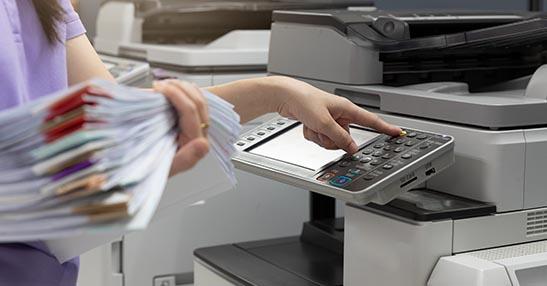
Hola mundo alerta alerta
Despite rapid digitization in organizations, industries will always depend on print devices for some aspect of their business. Since the technology is not going away, it is up to IT leaders within these organizations to ensure their print data security infrastructure is up to par in combatting the ever-evolving cyber threats. According to Quocirca’s 2023 report, 61% of organizations experienced data losses related to unsecured printing practices, underscoring the necessity of a robust print security strategy.¹ Below we will dive into the dangers of unsecured printing, explore considerations organizations should take into account when evaluating secure printing implementation and explain why WAVE ID® readers are a comprehensive solution to secure print environments.
Understanding the Risks of Unsecured Printing
Printers and multi-function printers (MFPs) are valuable assets within an organization but can pose substantial risks without proper security measures. When connected to your organization’s network and left unprotected, these devices can allow unauthorized users to access sensitive information, potentially exposing the entire network to malware attacks and data theft. This vulnerability has led agencies like the Cybersecurity and Infrastructure Security Agency (CISA) to highlight the importance of securing print spooler services in Emergency Directive (ED) 21-04, emphasizing that compromised print infrastructure can jeopardize an entire network.²
The Role of Secure Print Management
When implementing security solutions for your printer or printer fleets one of the main directives should be to ensure that only authorized personnel can retrieve print jobs. By implementing secure authentication readers, like the WAVE ID solution, organizations can significantly reduce unauthorized access. rf IDEAS readers leverage user credentials—such as ID badges, mobile devices or biometric data—to release print jobs only when the user is physically present at the device, ensuring that sensitive documents like financial statements or human resource records aren’t left unattended. This print management solution also provides an audit trail via job logging, so reports can be created containing who printed what and when.
Secure print also contributes to overall operational efficiency. By reducing unauthorized and uncollected print jobs, organizations can lower their printing costs and environmental impact. Unclaimed print jobs contribute to significant paper waste, impacting both budgets and sustainability efforts. In fact, paper accounts for 23% of total municipal solid waste generation.³ Controlling print access streamlines document management and ensures that only necessary print jobs are executed, which helps save on ink, paper, and device maintenance.
Finally, secure print solutions support regulatory compliance, a crucial aspect for industries like healthcare, finance, and education. Secure print solutions facilitate adherence to data protection laws like GDPR and HIPAA, helping organizations avoid potential fines and legal ramifications.
Practical Steps to Implement Secure Print
When it comes to implementing solutions to combat any potential data breaches, it will require careful planning and evaluation of both hardware and software needs.
- Assess Your Printer Fleet: Review the compatibility of your current print devices with secure print solutions. Older devices might lack the required firmware or interface to support secure print features, necessitating an upgrade. Additionally, MFPs shared by large groups may need separate authentication readers to streamline access.
- Evaluate Software Needs: Secure print solutions often integrate with various software tools for user authentication, tracking, and reporting. Choose software that aligns with your organization’s existing infrastructure and, if possible, supports remote management to streamline maintenance and troubleshooting across multiple locations. WAVE ID readers, for example, are compatible with leading print management software, including PaperCut, NT-Ware, HP Advance and others, offering flexible options for secure print management.
- Implement a Credential Strategy: Not all organizations use the same type of credentials from physical to logical access, and some may be transitioning to more secure options, such as mobile credentials. A secure print solution with rf IDEAS can support a range of credential types, including RFID cards, mobile devices, and NFC technology, to accommodate evolving credential strategies.
“Implementing secure print solutions like WAVE ID® readers helps businesses safeguard sensitive information and protect themselves against other types of fraud such as ransomware. By leveraging advanced authentication methods such as MFA, organizations can significantly reduce unauthorized access, enhance overall operational efficiency and meet regulatory compliance requirements.”
- Robert Shibata, Print Vertical Lead
Enhance Print Data Security with WAVE ID® Readers
Adopting WAVE ID readers can significantly improve the security of your print environment and we have the data to back it up. We offer comprehensive credential support and robust security features, with long-standing relationships with print OEM manufacturers such as HP, Ricoh, Xerox, Toshiba, Kyocera and Canon/NT-Ware to enable seamless integration. With features that support mobile credentials, passkey authentication, and the flexibility to integrate with different software, WAVE ID readers future-proof print environments while ensuring they meet today’s high-security standards. Plus, secure printing is just the beginning. Once your printer fleet is addressed, your organization can extend secure authentication to other parts of the enterprise, such as logical access control, multi-factor authentication (MFA) and single sign-on (SSO). These solutions help organizations implement Zero Trust security policies, ensuring only authorized users can access critical systems and data.

Contact us Today
1. https://quocirca.com/quocirca-print-security-landscape-2023/
2. https://www.cisa.gov/news-events/directives/ed-21-04-mitigate-windows-print-spooler-service-vulnerability
3. https://www.epa.gov/facts-and-figures-about-materials-waste-and-recycling/paper-and-paperboard-material-specific-data